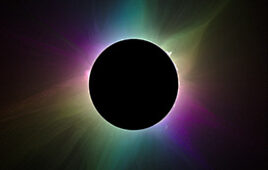
Credit: Queen’s University Belfast
The sun’s magnetic field is ten times stronger than previously believed, new research from Queen’s University Belfast and Aberystwyth University has revealed.
The new finding was discovered by Dr. David Kuridze, Research Fellow at Aberystwyth University. Dr. Kuridze began the research when he was based at Queen’s University Belfast and completed it when he moved to Aberystwyth University in 2017. He is a leading authority on the use of ground-based telescopes to study the sun’s corona, the ring of bright light visible during a total eclipse.
Working from the Swedish 1-m Solar Telescope at Roque de los Muchachos Observatory, La Palma in the Canary Islands, Dr. Kuridze studied a particularly strong solar flare which erupted near the surface of the sun on 10 September 2017.
A combination of favourable conditions and an element of luck enabled the team to determine the strength of the flare’s magnetic field with unprecedented accuracy. The researchers believe the findings have the potential to change our understanding of the processes that happen in the sun’s immediate atmosphere.
Speaking about the find, Dr. Kuridze said: “Everything that happens in the sun’s outer atmosphere is dominated by the magnetic field, but we have very few measurements of its strength and spatial characteristics.
“These are critical parameters, the most important for the physics of the solar corona. It is a little like trying to understand the Earth’s climate without being able to measure its temperature at various geographical locations.
“This is the first time we have been able to measure accurately the magnetic field of the coronal loops, the building blocks of the sun’s magnetic corona, which such a level of accuracy.”
Measuring 1,400,000 kilometres across (109 times larger than Earth) and 150,000,000 kilometres from Earth, the sun’s corona extends millions of kilometres above the surface.
Solar flares appear as bright flashes and occur when magnetic energy that has built up in the solar atmosphere is suddenly released.
Until now, successful measurement of the magnetic field has been hindered by the weakness of the signal from the sun’s atmosphere that reaches Earth and caries information about the magnetic field, and limitations in the instrumentation available.
The magnetic fields reported in this study are similar to those of a typical fridge magnet and around 100 times weaker than the magnetic field encountered in an MRI scanner.
However, they are still responsible for the confinement of the solar plasma, which make up solar flares, as far as 20,000 km above the sun’s surface.
Over a 10-day period in September 2017, Dr. Kuridze studied an active area on the sun’s surface which the team knew to be particularly volatile.
However, the telescope used can only focus on 1% of the sun’s surface at any given time. As luck would have it, Dr. Kuridze was focused on exactly the right area and at the right time when the solar flare erupted.
These solar flares can lead to storms which, if they hit Earth, form the northern lights – the Aurora Borealis.
They can also disrupt communications satellites and GPS systems, as proved to be the case on this occasion in September 2017.
Professor Michail Mathioudakis from the School of Mathematics and Physics, Queen’s University Belfast, who also worked on the project, added: “This is a unique set of observations that, for the first time, provide a detailed map of the magnetic field in coronal loops.
“This highly rewarding result was achieved due to the dedication and perseverance of our early career scientists who planned and executed the observations. The methodology used in this work and the result itself, will open new avenues in the study of the solar corona.”




